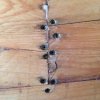I had great success using a Dremel type rotary tool as a grinder to remove only the very ends of the clinched tacks holding in each rib. Several advantages were apparent. 1) no chance of breaking or damaging planking. 2) importantly, the Dremel puts pressure in a very focused pea-sized spot, so sawdust and debris are minimal. 3) For the newbie canoe restorer or weekend craftsman there is almost no learning curve. 4) one doesn't use leverage or chisels or knives that, in the best of hands can slip and cause damage. 5) the rib comes out whole and can be used as a pattern.
You are using an out of date browser. It may not display this or other websites correctly.
You should upgrade or use an alternative browser.
You should upgrade or use an alternative browser.
Removing ribs using a Dremel type tool
- Thread starter ssommers
- Start date
I agree, use a similar technique, and would only add one comment: tap the tack with a punch and it usually falls out. If the rib resists coming out, perhaps stuck by varnish, run a hacksaw blade underneath. Attachment shows the 1 inch file sander I use which generates much more dust than your method. Tom McCloud
Attachments
Last edited:
Dave Osborn
LIFE MEMBER
Many ways to skin a cat.....
I hit them with a hammer and punch to pop the heads back above the plank for easy harvest.
Sometimes I'll sand the rib quickly with the random orbital so the clinched ends show up a little better.
I hit them with a hammer and punch to pop the heads back above the plank for easy harvest.
Sometimes I'll sand the rib quickly with the random orbital so the clinched ends show up a little better.
David McDaniel
Canoe Dude
These methods are fine for those who are in a hurry. But I find that the job is much more enjoyable NOT using power tools.
I use only hand tools and enjoy no noise or dust. This way I can enjoy listening to music and breathing clean air!
But this is just my "Old school outlook"!
I use only hand tools and enjoy no noise or dust. This way I can enjoy listening to music and breathing clean air!
But this is just my "Old school outlook"!
Yes, the dremel method is not perfect by any means. The little grinder spins so fast that it will cause little puffs of smoke as it chips away at the clinched tacks. Not much fun to inhale a gulp of burned cedar, varnish, and copper fumes! So I didn't include that in my first review of the process. However, I am still a fan of the method because, for me, the weekend craftsman, it really worked. Thank you to those who have posted additional tips and observations in the thread.
Greg Nolan
enthusiast
Craig Johnson
Lifetime member
as long as we are on the subject, here is an old post about my method. Less dust than a Dremel but more than hand tools.
http://forums.wcha.org/showthread.php?5448-removing-ribs
http://forums.wcha.org/showthread.php?5448-removing-ribs








